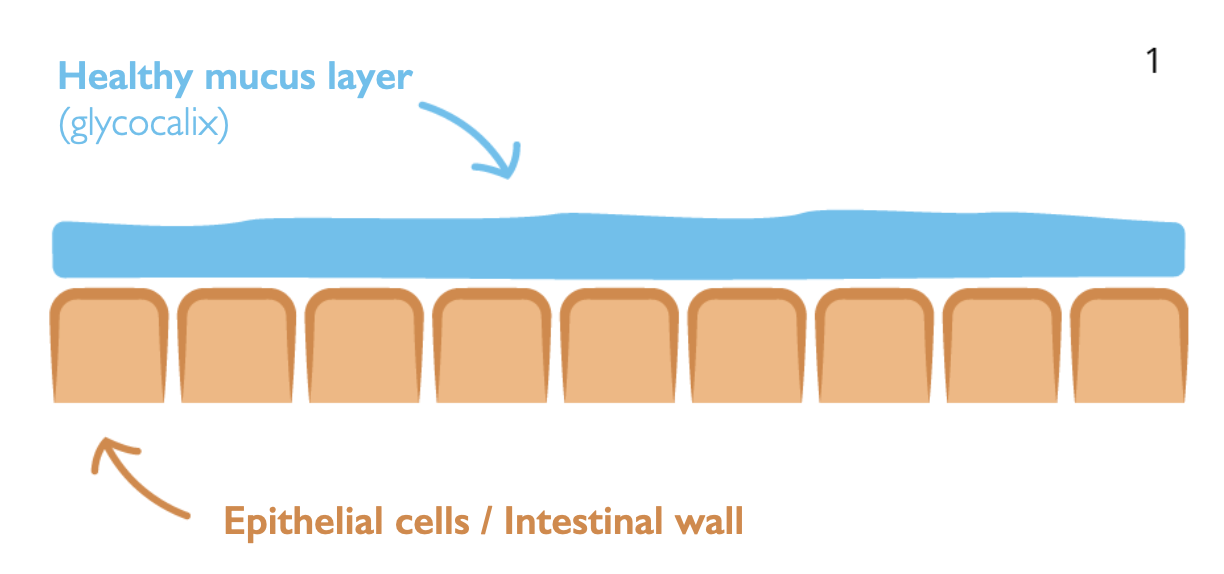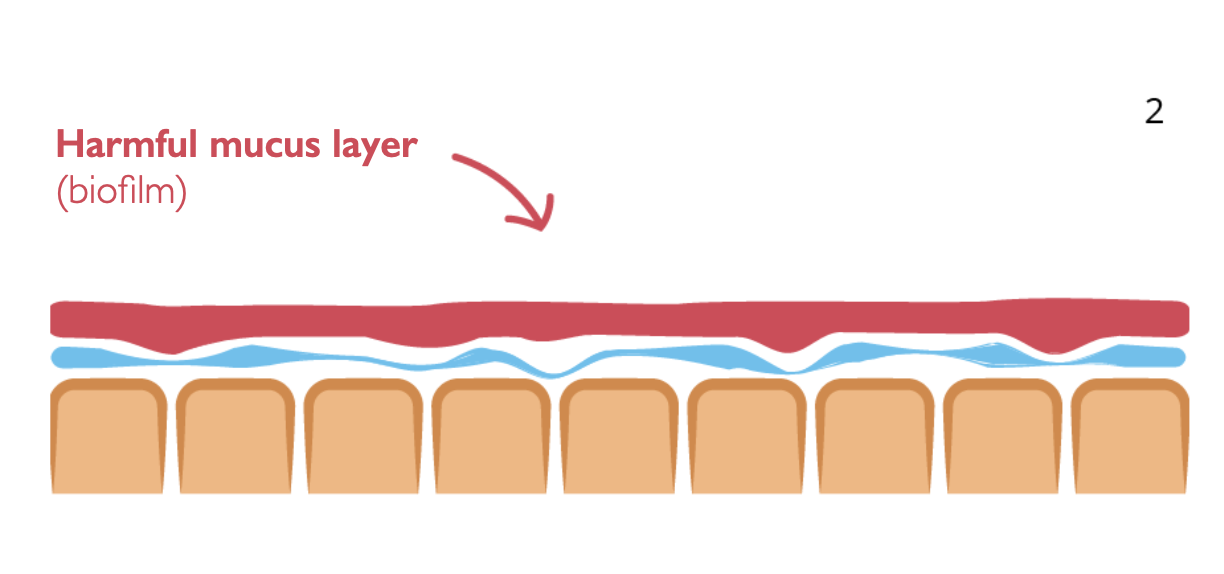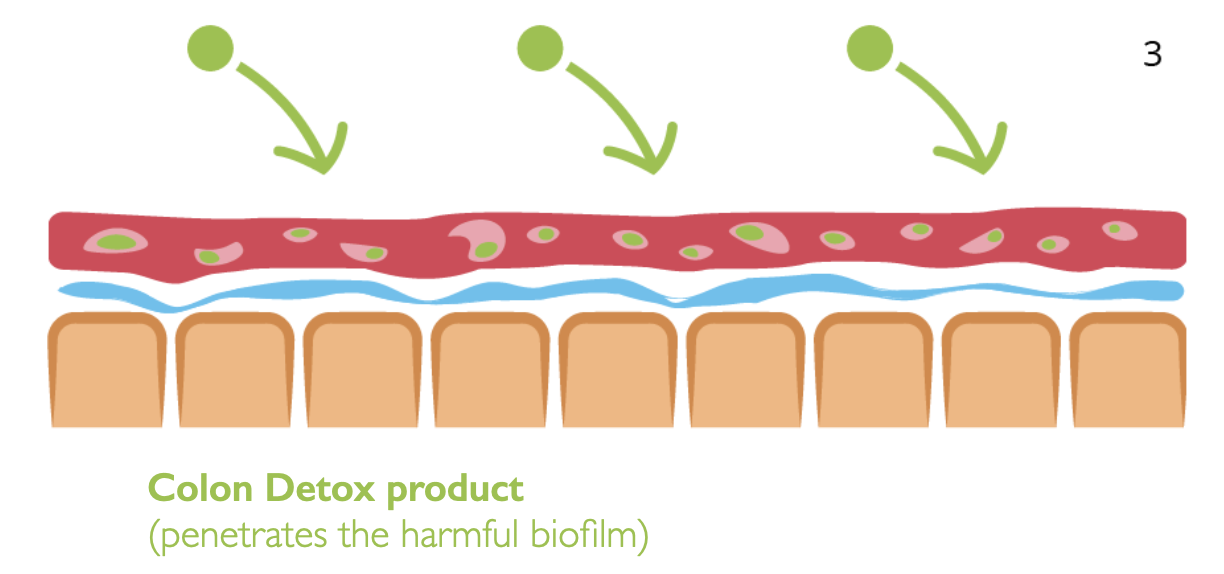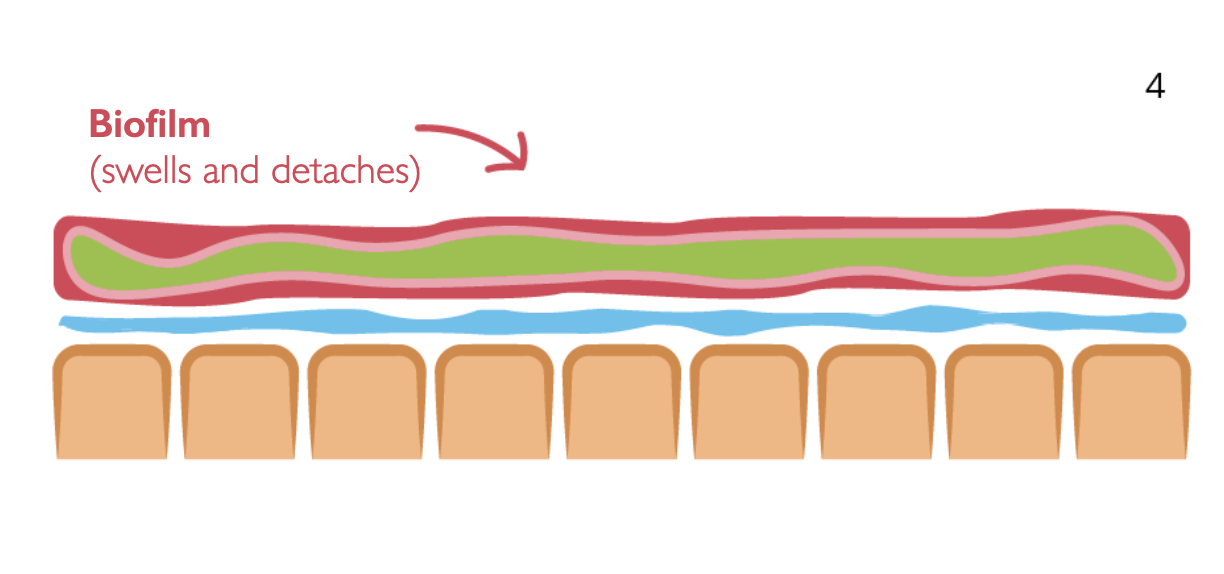Many therapists know the importance of a properly functioning colon as a first step to achieving health in the rest of the body. Given the number of unwanted substances we ingest every day, this can be difficult.
The human intestine is lined with a healthy mucus layer. This mucus layer protects the epithelial cells of the intestinal wall from being irritated by food in the system. In science, this mucus layer that protects the cells is called the glycocalix.

The balance in the intestine is disrupted
We can’t avoid ingesting many types of foreign substances, and we do so in quite large quantities. This leads to acidification which creates a suitable environment in the intestine for pathogenic, (harmful), bacteria to grow. As a result, we all have an excessive amount of pathogenic bacteria in our gut these days, and the balance of the intestine is disturbed by this.
Pathogenic bacteria also make a mucus layer: the biofilm
Many therapists try to restore balance within the gut using beneficial bacteria and other products, but that’s really only fighting symptoms and not the cause. The cause of the problem is too many pathogenic bacteria together forming a thick layer of mucus in which they live and are protected. This mucus layer is called the biofilm and it prevents unfriendly bacteria from being affected by the various digestive juices and washed away. The immune system itself could also attack and destroy them were it not for the biofilm. So this thick mucous layer enables the pathogenic bacteria to thrive in the intestine where nothing can affect them, not even natural or synthetic medicines.
The biofilm lies on top of the glycocalix, the healthy mucus layer. It is completely transparent in its natural state and so not visible on a colonoscopy. Some think that this biofilm also has a good effect because it is said to protect the intestinal wall. Unfortunately, the opposite is true.

There are biofilms in the whole body
To illustrate this point, consider the rest of the body. Everywhere pathogenic bacteria occur there is a biofilm. We find them in the sinuses, oral cavities, urinary tract, etc. The best known example is dental plaque, which is nothing more than a biofilm formed by harmful bacteria. Dental plaque has no function for the mouth or teeth and indeed we brush it away several times a day. If we didn’t, the biofilm would spread as white deposits throughout the mouth, causing it to become infected and damaging the teeth.
This same process is going on every day in the intestine and unfortunately we cannot clean the intestinal wall daily. The intestinal wall becomes inflamed and more permeable as a result. This is what lies behind what is often called ‘Leaky Gut’ Syndrome.
How to remove the biofilm
The best way to tackle the cause of Leaky Gut Syndrome is to get rid of the biofilm. However, this is not easy. The biofilm is impenetrable to most substances, so supplements based on enzymes or highly abrasive agents are often used. These, unfortunately, have many drawbacks.
Enzymes can dissolve parts of the biofilm. However, that process results in harmful bacteria being released into the gut and then being absorbed into the blood. This can make a person quite ill in what is sometimes called a ‘recovery crisis’. The remedy is usually worse than the disease in this case.
There are also remedies containing fibre which abrade the biofilm. However, the intestinal wall under the biofilm is already damaged, dried out and inflamed. Using abrasive agents is too intense for the colon wall, which is already sensitive.
The biofilm does not contain benign bacteria
There is a misunderstanding that the biofilm also provides shelter for benign, or ‘friendly’ bacteria. The biofilm is only formed by harmful bacteria which have a different kind of behaviour than benign bacteria. Benign bacteria have their own mucus, but they do not clump together and do not clog the healthy mucus layer (glycocalyx). Unfortunately, this makes the good bacteria quite vulnerable to most methods of colon cleansing.
Combination of ingredients to cleanse the entire intestinal system
Fortunately, there are now natural substances which can deal with the biofilm efficiently, safely and without harming either the intestinal wall or the beneficial bacteria. Two ingredients that work together to release the biofilm from the intestinal wall so that it can pass out naturally are fermented palm bark fibre and okra powder.
Fermented palm bark fiber for tackling the biofilm
Palm bark fiber in its pure state is unusable in the body. But if the correct type is treated and fermented properly, it acquires several properties suitable for tackling the biofilm.This specific fiber is the only ingredient in the world with the property of penetrating the biofilm without damaging it. Further, it does so without destroying the biofilm and releasing the harmful bacteria into the gut where they may be absorbed. The palm bark fiber leaves the biofilm intact and also acts as a transporter for another ingredient, powdered okra.
(Incidentally, for reasons of environmental sustainability, it is important that only palms are used which have reached the end of their lifespan and been cut down for other reasons. The use of the bark in colon treatments is then no more than a byproduct which leaves zero environmental footprint.)

Okra powder and removing the biofilm
Okra is a vegetable resembling a small squash and is widely consumed in many parts of the world. Powdered, it can absorb more than 100 times its own weight in water. Using fermented palm fiber, the okra powder can be transported into the biofilm, where it will absorb a great deal of water. This causes the biofilm, normally a thin, transparent film, to swell enormously. It becomes very slippery and top heavy and so separates from the intestinal wall without causing any irritation. The only thing the dried-out intestinal wall notices is that it finally has sufficient moisture.The biofilm itself comes off the intestinal wall as though it were the skin of a sausage and passes out with the next bowel movement.
With the biofilm gone, the healthy mucus layer can revive completely, no longer being suffocated and dried out.


Combination oil palm fiber and okra is essential
Combining the fermented palm bark with okra powder is the most effective way to quickly and easily remove the biofilm without damaging the intestinal wall or the microbiome. None of the bacteria, chemicals or heavy metals which the biofilm contains are released. As a result, this treatment is not hard on the person doing it and is far friendlier than other methods available to date.